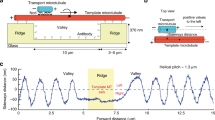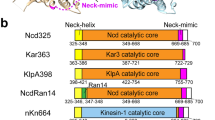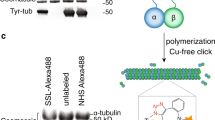Abstract
Conventional isoforms of the motor protein kinesin behave functionally not as ‘single molecules’ but as ‘two molecules’ paired. This dimeric structure poses a barrier to solving its mechanism1,2,3,4. To overcome this problem, we used an unconventional kinesin KIF1A (refs 5, 6) as a model molecule. KIF1A moves processively as an independent monomer7,8, and can also work synergistically as a functional dimer9. Here we show, by measuring its movement with an optical trapping system10, that a single ATP hydrolysis triggers a single stepping movement of a single KIF1A monomer. The step size is distributed stochastically around multiples of 8 nm with a gaussian-like envelope and a standard deviation of 15 nm. On average, the step is directional to the microtubule's plus-end against a load force of up to 0.15 pN. As the source for this directional movement, we show that KIF1A moves to the microtubule's plus-end by ∼3 nm on average on binding to the microtubule, presumably by preferential binding to tubulin on the plus-end side. We propose a simple physical formulation to explain the movement of KIF1A.
This is a preview of subscription content, access via your institution
Access options
Subscribe to this journal
Receive 51 print issues and online access
$199.00 per year
only $3.90 per issue
Buy this article
- Purchase on Springer Link
- Instant access to full article PDF
Prices may be subject to local taxes which are calculated during checkout



Similar content being viewed by others

References
Hua, W., Chung, J. & Gelles, J. Distinguishing inchworm and hand-over-hand processive kinesin movement by neck rotation measurements. Science 295, 844–848 (2002)
Kaseda, K., Higuchi, H. & Hirose, K. Coordination of kinesin's two heads studied with mutant heterodimers. Proc. Natl Acad. Sci. USA 99, 16058–16063 (2002)
Rice, S. et al. A structural change in the kinesin motor protein that drives motility. Nature 402, 778–784 (1999)
Gilbert, S. P., Moyer, M. L. & Johnson, K. A. Alternating site mechanism of the kinesin ATPase. Biochemistry 37, 792–799 (1998)
Okada, Y., Yamazaki, H., Sekine Aizawa, Y. & Hirokawa, N. The neuron-specific kinesin superfamily protein KIF1A is a unique monomeric motor for anterograde axonal transport of synaptic vesicle precursors. Cell 81, 769–780 (1995)
Hirokawa, N. Kinesin and dynein superfamily proteins and the mechanism of organelle transport. Science 279, 519–526 (1998)
Okada, Y. & Hirokawa, N. Mechanism of the single-headed processivity: diffusional anchoring between the K-loop of kinesin and the C terminus of tubulin. Proc. Natl Acad. Sci. USA 97, 640–645 (2000)
Okada, Y. & Hirokawa, N. A processive single-headed motor: Kinesin superfamily protein KIF1A. Science 283, 1152–1157 (1999)
Tomishige, M., Klopfenstein, D. R. & Vale, R. D. Conversion of Unc104/KIF1A kinesin into a processive motor after dimerization. Science 297, 2263–2267 (2002)
Nishiyama, M., Muto, E., Inoue, Y., Yanagida, T. & Higuchi, H. Substeps within the 8-nm step of the ATPase cycle of single kinesin molecules. Nature Cell Biol. 3, 425–428 (2001)
Nishiyama, M., Higuchi, H. & Yanagida, T. Chemomechanical coupling of the forward and backward steps of single kinesin molecules. Nature Cell Biol. 4, 790–797 (2002)
Kikkawa, M. et al. Switch-based mechanism of kinesin motors. Nature 411, 439–445 (2001)
Block, S. M., Goldstein, L. S. & Schnapp, B. J. Bead movement by single kinesin molecules studied with optical tweezers. Nature 348, 348–352 (1990)
Endow, S. A. & Higuchi, H. A mutant of the motor protein kinesin that moves in both directions on microtubules. Nature 406, 913–916 (2000)
Svoboda, K., Schmidt, C. F., Schnapp, B. J. & Block, S. M. Direct observation of kinesin stepping by optical trapping interferometry. Nature 365, 721–727 (1993)
Kikkawa, M., Okada, Y. & Hirokawa, N. 15 Å resolution model of the monomeric kinesin motor, KIF1A. Cell 100, 241–252 (2000)
Veigel, C. et al. The motor protein myosin-I produces its working stroke in two steps. Nature 398, 530–533 (1999)
Hackney, D. D. Pathway of ADP-stimulated ADP release and dissociation of tethered kinesin from microtubules. Implications for the extent of processivity. Biochemistry 41, 4437–4446 (2002)
Astumian, R. D. Thermodynamics and kinetics of a Brownian motor. Science 276, 917–922 (1997)
Julicher, F., Ajdari, A. & Prost, J. Modeling molecular motors. Rev. Mod. Phys. 69, 1269–1281 (1997)
Farrell, C. M., Mackey, A. T., Klumpp, L. M. & Gilbert, S. P. The role of ATP hydrolysis for kinesin processivity. J. Biol. Chem. 277, 17079–17087 (2002)
Berliner, E., Young, E. C., Anderson, K., Mahtani, H. K. & Gelles, J. Failure of a single-headed kinesin to track parallel to microtubule protofilaments. Nature 373, 718–721 (1995)
Inoue, Y. et al. Movements of truncated kinesin fragments with a short or an artificial flexible neck. Proc. Natl Acad. Sci. USA 94, 7275–7280 (1997)
Howard, J. & Hyman, A. A. Preparation of marked microtubules for the assay of the polarity of microtubule-based motors by fluorescence microscopy. Methods Cell Biol. 39, 105–113 (1993)
deCastro, M. J., Fondecave, R. M., Clarke, L. A., Schmidt, C. F. & Stewart, R. J. Working strokes by single molecules of the kinesin-related microtubule motor ncd. Nature Cell Biol. 2, 724–729 (2000)
Acknowledgements
We thank T. J. Mitchison for the gift of GMPCPP; H. Fukuda, H. Sato and M. Sugaya for technical and secretarial assistance; and J. Howard, M. Kikkawa and our colleagues for discussion. This work was supported by a Center of Excellence Grant-in-Aid (N.H.) and a Grant-in-Aid (H.H.) from the Ministry of Education, Culture, Sports, Science and Technology of Japan.
Author information
Authors and Affiliations
Corresponding author
Ethics declarations
Competing interests
The authors declare that they have no competing financial interests.
Supplementary information
41586_2003_BFnature01804_MOESM2_ESM.doc
Supplementary Information 2: Stochastic oscillation by a single KIF1A monomer and rapid, kinesin dimer-like movement by the clustering of KIF1A (DOC 243 kb)
41586_2003_BFnature01804_MOESM3_ESM.doc
Supplementary Information 3: Load dependence of the amplitude and the position of the stochastic oscillation of KIF1A-beads (DOC 136 kb)
Rights and permissions
About this article
Cite this article
Okada, Y., Higuchi, H. & Hirokawa, N. Processivity of the single-headed kinesin KIF1A through biased binding to tubulin. Nature 424, 574–577 (2003). https://doi.org/10.1038/nature01804
Received:
Accepted:
Issue Date:
DOI: https://doi.org/10.1038/nature01804
This article is cited by
-
Kinesin-3 motors are fine-tuned at the molecular level to endow distinct mechanical outputs
BMC Biology (2022)
-
A 6-nm ultra-photostable DNA FluoroCube for fluorescence imaging
Nature Methods (2020)
-
Physical parameters describing neuronal cargo transport by kinesin UNC-104
Biophysical Reviews (2019)
-
Run-and-pause dynamics of cytoskeletal motor proteins
Scientific Reports (2016)
-
Formation of helical membrane tubes around microtubules by single-headed kinesin KIF1A
Nature Communications (2015)
Comments
By submitting a comment you agree to abide by our Terms and Community Guidelines. If you find something abusive or that does not comply with our terms or guidelines please flag it as inappropriate.


